French-Italian singer, jazz musician and actor Nino Ferrer (1934-1998) was an immensely popular pop star during the second half of the 1960s. L'homme a tout faire (The Jack of all Trades) also appeared in seven films.
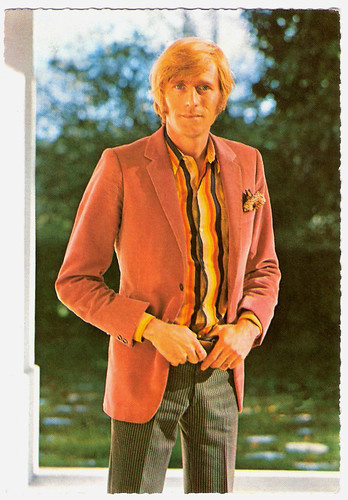
French postcard by Publistar / Riviera, no. 1426. Photo: Gérard Bousquet.
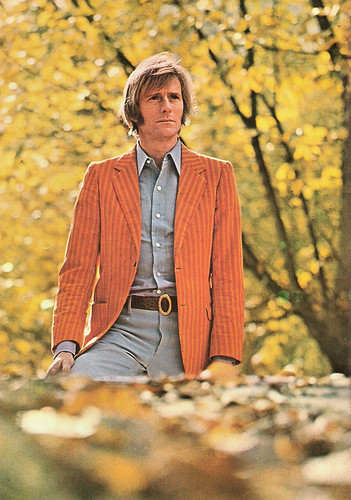
Italian postcard by Grafiche Biondetti (GB), Verona, no. 54.
Nino Ferrer was born Nino Agostino Arturo Maria Ferrari in Genoa, Italy, in 1934. He had an Italian father and a French mother. A considerable part of his pre-teen years was spent under the stress of World War II, but Nino himself later declared having had a pleasant childhood in a bourgeois, art-loving family. His father worked as an engineer in a nickel mine in New Caledonia.
On holiday in France in 1939, Nino and his mother were unable to leave Europe because of World War II. While his father carried on working in New Caledonia, they spent difficult years stuck and penniless in Italy, where Nino’s mother was considered the wife of an enemy. In 1947, the family, re-united and moved to France. Nino was sent to the best colleges in Paris and earned a degree in ethnology and prehistoric archaeology. As a student, much of his free time was spent on archaeological digs and his first job was at the Musée de l'Homme with André Leroi-Gourhan. Alongside his passion for history, he developed numerous other interests.
He became a keen painter and remained so until his death. Above all, he learned to play several instruments (piano, guitar, clarinet, trombone and trumpet) and composed, wrote lyrics and became a fervent jazz lover. When he finished his studies, his grandmother offered him a trip to New Caledonia, a gift he took advantage of by going around the world on a cargo ship.
On his return to Paris, he tried several jobs. Starting out as a hired hand in the capital's jazz circles, he was employed by bandleader Richard Bennett and later worked for Nancy Holloway, an American jazz and rock singer, who was popular in France in the 1960s. He also continued to write gospel-inspired songs which received only refusals from most of the record companies. Hearing Otis Redding and Sam Cooke for the first time was a musical revelation and transformed his writing style. Although already spotted by the Barclay record label, he had to wait until 1963 to record his first release, 'Pour oublier qu’on s’est aimé'. He was 29, whereas most of the young stars of the time were hardly 20. It was a four-track EP, written in a fairly classical vein, and did not sell well in France.
However, one of the tracks, 'C'est Irréparable', was a hit in some European countries, in Japan and even in the Middle East. The song was picked up by Italian Mina as Un anno d'amore, hitting #1 on the Italian singles chart. Having left Barclay for a small label, Bel Air, Nino Ferrer was still unknown in France. In 1964, he started a gospel group, Reverend Nino and the Jubilees, but it broke up before recording anything worth being released. He had small parts in two Policiers starring hard-boiled Eddie Constantine, Laissez tirer les tireurs/Let the Marksman Fire (Guy Lefranc, 1964) and Ces dames s'en mêlent/These Ladies Get Involved in It (Raoul André, 1965), and he also went on to bring out several solo singles, but all without any success.

French postcard in the Collection Princesse series. Photo: Disques Riviera.
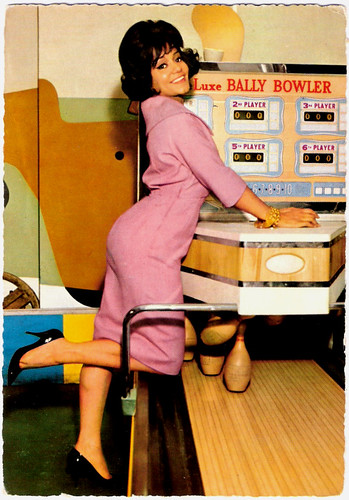
Nancy Holloway. German postcard by Krüger, no. 902/266. Photo: Neuvelle.
After so many lean years, Nino Ferrer’s big break came unexpectedly in 1965 when he returned to Barclay, which gave him the chance to record his new material. After a few unsuccessful trials, a new artistic director, Richard Bennett, gave Nino free rein to record his compositions as he wanted. And so Nino Ferrer recorded 'Mirza', an effective cocktail of rhythm ‘n’ blues and caustic lyrics. The song was immediately a huge hit.
His record company called for more songs in the same vein. These records sold very well and overnight he became an idol. Now the zany singer in vogue, he followed 'Mirza' up with 'Les Cornichons' and 'Oh! Hé! Hein! Bon'. Although he was now very popular, his success was founded on material with which he never felt really comfortable.
Nevertheless, hit followed hit and he lived his new life as a star at breakneck rhythm. In 1966, he gave 195 live performances and made nearly thirty TV appearances. As an actor, he appeared in the TV film Palpitations (Marcel Moussy, 1966). He soon grew tired of his deliberately 'blasé' and provocative seducer image of which people compared him to Jacques Dutronc. In 1966 he released 'Le Téléfon', another hit to which people are still dancing years later.
He left Paris for Italy where, at the same time, his song 'Je veux être noir' was a success of an entirely different kind. Smothered by his own success, Nino stayed about three years in Italy, from 1967 to 1970. In France, his releases continued to sell well. His lyrics became increasingly iconoclastic, even politicised while remaining just as sarcastic or even cynical. In 1967, he brought out 'Mao et Moa' and 'Mon copain Bismarck' and in 1968, 'le Roi d’Angleterre', with biting lyrics echoing his irritation with show business and society in general. Around this time, Nino hired a young organist from Cameroon, Manu Dibango, later to become famous as a saxophonist. In Italy, Nino became notorious in 1969 as the presenter of the satirical TV variety show, Io, Agata e tu with Raffaella Carrà, famed for the disco smash 'A far l'amore comincia tu' (1977).
Ferrer also played in three films: the Canadian TV film L'homme qui venait du Cher/The Man Who Came from Cher (Maurice Dumay, 1969) with Eddy Mitchell, the French production Delphine (Eric Le Hung, 1969) starring Dany Carrel, and the French-Italian drama Un été sauvage/A Savage Summer (Marcel Camus, 1970) with Juliet Berto, and he also composed the soundtrack of the Belgian-French film Il pleut dans ma maison/It Rains in my House (Pierre Laroche, 1969). Then, after a brief love affair with Brigitte Bardot, Nino Ferrer decided to return to France in 1970.
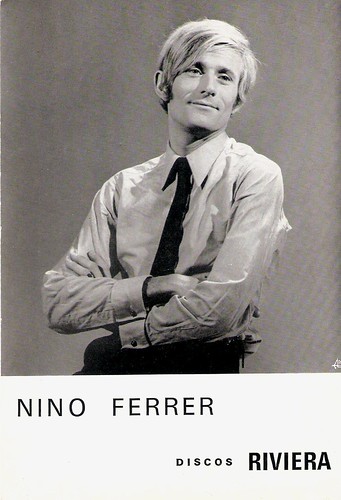
Portugese postcard by Radio Triunfo, Porto, no. 20008, 1966. Photo: Discos Riviera.
Determined now to conduct his career as he alone saw fit, Nino Ferrer took up residence in the South West of France and began breeding horses. But music remained his first love and his meeting with Englishman Mickey Finn, a guitarist who had played with T.Rex, Eric Clapton and the Rolling Stones, changed his attitude towards his work.
With Mickey Finn, Nino launched into rock music and began to write darker, more personal lyrics. 1972 saw the release of the 'Métronomie' album, considered by Ferrer to be his first ‘real’ album. Very much in the style of the time, the album was conceived as an ‘experience’, with the music accompanied by sound effects, but included a new version of his very first release, Pour oublier qu’on s’est aimé. However, it was not the album which sold but one of its tracks, La Maison près de la fontaine. Very different from the rest of the album, the single sold more than 500,000 copies. Yet again, the red carpet was unrolled for Nino which only redoubled his contempt for show business.

French postcard by Publistar / Riviera, no. 1426. Photo: Gérard Bousquet.

Italian postcard by Grafiche Biondetti (GB), Verona, no. 54.
Musical revelation
Nino Ferrer was born Nino Agostino Arturo Maria Ferrari in Genoa, Italy, in 1934. He had an Italian father and a French mother. A considerable part of his pre-teen years was spent under the stress of World War II, but Nino himself later declared having had a pleasant childhood in a bourgeois, art-loving family. His father worked as an engineer in a nickel mine in New Caledonia.
On holiday in France in 1939, Nino and his mother were unable to leave Europe because of World War II. While his father carried on working in New Caledonia, they spent difficult years stuck and penniless in Italy, where Nino’s mother was considered the wife of an enemy. In 1947, the family, re-united and moved to France. Nino was sent to the best colleges in Paris and earned a degree in ethnology and prehistoric archaeology. As a student, much of his free time was spent on archaeological digs and his first job was at the Musée de l'Homme with André Leroi-Gourhan. Alongside his passion for history, he developed numerous other interests.
He became a keen painter and remained so until his death. Above all, he learned to play several instruments (piano, guitar, clarinet, trombone and trumpet) and composed, wrote lyrics and became a fervent jazz lover. When he finished his studies, his grandmother offered him a trip to New Caledonia, a gift he took advantage of by going around the world on a cargo ship.
On his return to Paris, he tried several jobs. Starting out as a hired hand in the capital's jazz circles, he was employed by bandleader Richard Bennett and later worked for Nancy Holloway, an American jazz and rock singer, who was popular in France in the 1960s. He also continued to write gospel-inspired songs which received only refusals from most of the record companies. Hearing Otis Redding and Sam Cooke for the first time was a musical revelation and transformed his writing style. Although already spotted by the Barclay record label, he had to wait until 1963 to record his first release, 'Pour oublier qu’on s’est aimé'. He was 29, whereas most of the young stars of the time were hardly 20. It was a four-track EP, written in a fairly classical vein, and did not sell well in France.
However, one of the tracks, 'C'est Irréparable', was a hit in some European countries, in Japan and even in the Middle East. The song was picked up by Italian Mina as Un anno d'amore, hitting #1 on the Italian singles chart. Having left Barclay for a small label, Bel Air, Nino Ferrer was still unknown in France. In 1964, he started a gospel group, Reverend Nino and the Jubilees, but it broke up before recording anything worth being released. He had small parts in two Policiers starring hard-boiled Eddie Constantine, Laissez tirer les tireurs/Let the Marksman Fire (Guy Lefranc, 1964) and Ces dames s'en mêlent/These Ladies Get Involved in It (Raoul André, 1965), and he also went on to bring out several solo singles, but all without any success.

French postcard in the Collection Princesse series. Photo: Disques Riviera.

Nancy Holloway. German postcard by Krüger, no. 902/266. Photo: Neuvelle.
A brief love affair with Brigitte Bardot
After so many lean years, Nino Ferrer’s big break came unexpectedly in 1965 when he returned to Barclay, which gave him the chance to record his new material. After a few unsuccessful trials, a new artistic director, Richard Bennett, gave Nino free rein to record his compositions as he wanted. And so Nino Ferrer recorded 'Mirza', an effective cocktail of rhythm ‘n’ blues and caustic lyrics. The song was immediately a huge hit.
His record company called for more songs in the same vein. These records sold very well and overnight he became an idol. Now the zany singer in vogue, he followed 'Mirza' up with 'Les Cornichons' and 'Oh! Hé! Hein! Bon'. Although he was now very popular, his success was founded on material with which he never felt really comfortable.
Nevertheless, hit followed hit and he lived his new life as a star at breakneck rhythm. In 1966, he gave 195 live performances and made nearly thirty TV appearances. As an actor, he appeared in the TV film Palpitations (Marcel Moussy, 1966). He soon grew tired of his deliberately 'blasé' and provocative seducer image of which people compared him to Jacques Dutronc. In 1966 he released 'Le Téléfon', another hit to which people are still dancing years later.
He left Paris for Italy where, at the same time, his song 'Je veux être noir' was a success of an entirely different kind. Smothered by his own success, Nino stayed about three years in Italy, from 1967 to 1970. In France, his releases continued to sell well. His lyrics became increasingly iconoclastic, even politicised while remaining just as sarcastic or even cynical. In 1967, he brought out 'Mao et Moa' and 'Mon copain Bismarck' and in 1968, 'le Roi d’Angleterre', with biting lyrics echoing his irritation with show business and society in general. Around this time, Nino hired a young organist from Cameroon, Manu Dibango, later to become famous as a saxophonist. In Italy, Nino became notorious in 1969 as the presenter of the satirical TV variety show, Io, Agata e tu with Raffaella Carrà, famed for the disco smash 'A far l'amore comincia tu' (1977).
Ferrer also played in three films: the Canadian TV film L'homme qui venait du Cher/The Man Who Came from Cher (Maurice Dumay, 1969) with Eddy Mitchell, the French production Delphine (Eric Le Hung, 1969) starring Dany Carrel, and the French-Italian drama Un été sauvage/A Savage Summer (Marcel Camus, 1970) with Juliet Berto, and he also composed the soundtrack of the Belgian-French film Il pleut dans ma maison/It Rains in my House (Pierre Laroche, 1969). Then, after a brief love affair with Brigitte Bardot, Nino Ferrer decided to return to France in 1970.

Portugese postcard by Radio Triunfo, Porto, no. 20008, 1966. Photo: Discos Riviera.
Darker, more personal lyrics
Determined now to conduct his career as he alone saw fit, Nino Ferrer took up residence in the South West of France and began breeding horses. But music remained his first love and his meeting with Englishman Mickey Finn, a guitarist who had played with T.Rex, Eric Clapton and the Rolling Stones, changed his attitude towards his work.
With Mickey Finn, Nino launched into rock music and began to write darker, more personal lyrics. 1972 saw the release of the 'Métronomie' album, considered by Ferrer to be his first ‘real’ album. Very much in the style of the time, the album was conceived as an ‘experience’, with the music accompanied by sound effects, but included a new version of his very first release, Pour oublier qu’on s’est aimé. However, it was not the album which sold but one of its tracks, La Maison près de la fontaine. Very different from the rest of the album, the single sold more than 500,000 copies. Yet again, the red carpet was unrolled for Nino which only redoubled his contempt for show business.
In 1973 he and Finn started the group Leggs, who would accompany Ferrer on several albums from this point onward. On these, he would switch directions many times: from rock & roll to gospel and from prog rock to laid-back funk. The latter style made up most of Nino and Radiah (1974), which included another fruitful Estardy collaboration in the song Ferrer is best remembered for in France: 'Le Sud'. It became one of Ferrer’s biggest hits, selling over a million copies. However, once again, the success of one track had overshadowed all the hard work on the rest of the album.
The following year, he brought out 'Suite en œuf', a commercial flop. The same was true of 'Véritables vérités verdâtres', (1977) which marked his departure from CBS. The success of 'Le Sud' nevertheless enabled Ferrer to buy a 15th-century fortress at Lataillade, where he installed a recording studio and continued raising horses and painting.
In 1978, he married Jacqueline Monestier, known as Kinou. Now without a record company, Ferrer released each new album on a different label. In 1979, he brought out 'Blanat' on a small independent label, Free Bird. This gospel-inspired, even jazz-orientated album had again both English and French lyrics. The same year, Ferrer met Jacques Higelin and went on tour with him. The rock singer’s crazy imagination and powerful personality seduced Ferrer and encouraged him to perform live again, a practice he had abandoned a long time before.
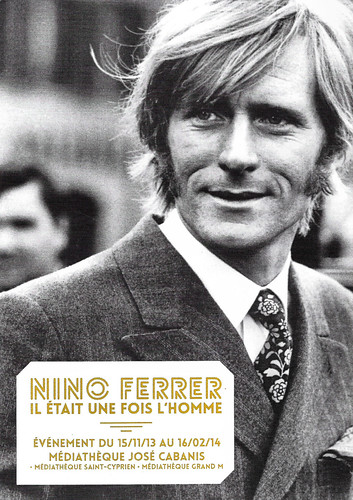
French promotion card by Bibliothèque de Toulouse. Photo: Pietro Pascuttini. Caption: Nino Ferrer - Il était une fois l'homme. Événement du 15/11/13 au 16/02/14, Médiathèque José Cabanis, Médiathèque Saint-Cyprien, Médiathèque Grand M.
Death in a cornfield
1981 was a year both of return and departure for Nino Ferrer. He brought out another rock and roll album in the Leggs vein, 'Rock ‘n’ Roll Cowboy', and sang at l’Olympia, the most prestigious of the Paris music venues. Yet, that same year, Ferrer slammed the door on show business definitively. Nevertheless, he appeared the following year in a stage musical for children, 'L’Arche de Noé', at the Théâtre de l’Unité in Paris. Composer of the music, he also played God in this moderately successful show.
He both composed the soundtrack and co-starred in the surreal, dreamlike horror film Litan (Jean-Pierre Mocky, 1982) with Marie-José Nat, but it was to be his last film appearance. From the end of 1984 until 1986, Ferrer totally disappeared from the cultural scene. He retired to his castle where he painted, had several exhibitions and brought up his two sons, Pierre and Arthur. Nevertheless, he recorded an album in 1986, soberly entitled, 13ème album, whose release went almost unnoticed.
It was on the new FNAC label that Ferrer made his come-back in 1993. That year, he released an album of entirely original material, recorded for the most part at Lataillade. The sleeve and the lyrics were illustrated by the singer’s own paintings. Co-written with Mickey Finn, the album, as its title La Désabusion (a play on the words désabuser and illusion) suggests, marked only a half-hearted, morose return. For around two years after La Désabusion, Ferrer popped up in the news here and there. In 1994, he had an exhibition in Paris, published a collection of his writings and continued to promote the album. Then, from April to June 1995, he went on tour for the first time in years, with his faithful group, the Leggs. He was a guest at the Francofolies festival in La Rochelle in July.
Also that year, he released a small ten-track album of original material recorded at home. A genuine family effort, recorded between 1987 and 1992, it includes versions of old hits such as 'Mirza' and 'Le Sud', traditional folk songs, all of them sung by his wife Kinou, his son Arthur, Mickey Finn and other musicians. There followed another period of silence spent in the company of family and friends and helping Arthur, now a student like his brother, to prepare a debut album. In 1998, his mother Mounette’s death left a vacuum in Nino's life. A month later, Ferrer shot himself in the heart in the middle of a cornfield a few kilometres from his home, two days before his 64th birthday.
The anonymous biographer at English Wikipedia concludes: “An unpredictable, moody character, Ferrer refused artistic compromise and therefore compromised his career. Nevertheless, with songs as different as 'Les Cornichons' and 'Le Sud', he left behind several indelible traces in French musical heritage, not forgetting numerous songs now hardly known.” But his songs can be heard on the soundtracks of some popular films. 'C'est irreparable' can be heard in Pedro Almodovar’s comedy-drama Tacones lejanos/High Heels (1991) and in Bernardo Bertolucci’s The Dreamers (2003), while 'Les Cornichons' is featured on the soundtrack of the romantic comedy J'me sens pas belle/Tell Me I’m Pretty (Bernard Jeanjean, 2004).
Live performance of Les cornichons. Source: Azitis (YouTube).
Sources: Nino Ferrer.com, Quint Kik (AllMusic), Wikipedia and IMDb.
This post was last updated on 10 March 2024.
What an interesting and tragic story. Yet another fascinating bit of history I would never have known. Thank you Bob and Merry Christmas to you and family.
ReplyDeleteYou might be interested in this recent italian version of "Mizra" Nino Ferrer 1965 :
ReplyDeletehttps://www.youtube.com/watch?v=S3TYlV9WEnA
Funny version, but we love Nino's original.
ReplyDelete